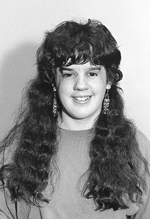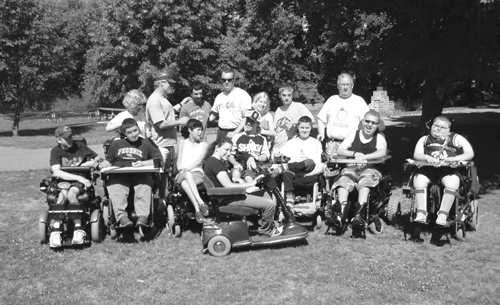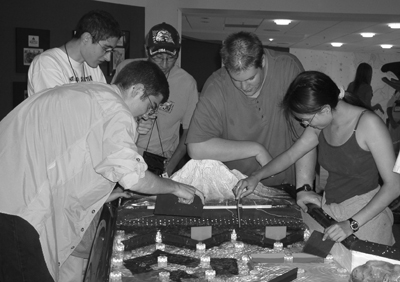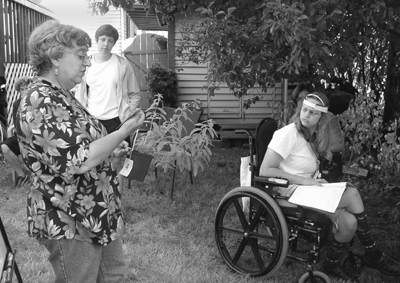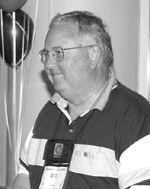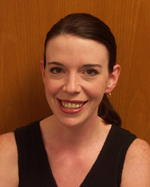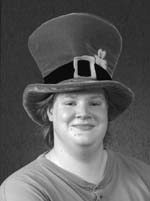Summer Study '04: What Do the Phase I Scholars Do?
DO-IT Phase I Scholars participate in a two-week, live-in Summer Study session on the University of Washington campus in Seattle, Washington. They learn about college life; surf the Internet; interact with peers, staff, and mentors; and have fun. Below, '04 Phase I Scholars share some of their experiences.
Service Dogs: Friends and Workers
by Phase I Scholars Vishal and Lukas
From an observer's perspective
My name is Vishal. In DO-IT Summer Study this year, we got to know three service dogs and their companions quite well. Through observing these dogs and their companions, I learned a lot.
These three dogs, Mystere, Fisher, and Silly, are perfect matches for their companions Lukas, Maryann, and Meg, respectively. They were always by their companions unless it was nighttime and they were "off duty." The love from these dogs is obvious. At one time, during photo day, Fisher and Mystere got up on their companions' laps to be in the pictures with them. It is amazing that they are so obedient and respond to their companions so well. Which brings me to training for service dogs. From what I observed, the dogs and their companions must have gone through rigorous training to get to the point where the dogs obey commands so well and for their companions to have the type of composure necessary to teach their dogs. Although service dogs have training at an organization, they still have to learn with their companions!
Last but not least, the dogs have fun also! During the evening when we were done with the day's classes and had dorm activities, the companions took off the dogs' work harnesses, which they wear all day when "on duty." Taking these harnesses off signaled to the dogs that they were "off duty." Then they would roam around looking for people to play with or be petted by. One day, Fisher and Mystere were wrestling each other, with Robert kind of playing as well, while a lot of us watched. It was fun to see them play and have fun. These three dogs are truly amazing and so are their companions. We love ya pups!
From a companion's perspective
My name is Lukas and my service dog is Mystere. I love having Mystere as my service dog but, more importantly, as my companion. She is always there for me. I love knowing that my parents and my brother can leave me at the house alone, but I don't ever feel alone, because Mystere is there. I'm thankful everyday that Mystere is a part of my life. Yes, the paperwork, training, and everyday work is long and hard, but it all pays off. I look at this as investing a little chunk of time to receive an enormous return. I thank the organization I got Mystere from for everything they have done to make owning Mystere possible. You guys are outstanding!
Microsoft Field Trip
by Phase I Scholars Andrew and Bud
On our Microsoft trip we had a good time. When we got there, we were taken into a soundstage where we heard an interesting lecture about Windows™TM accessibility. After the lecture they brought in pizza and we ate and socialized for a while before the next activity began. After lunch, a panel of Microsoft employees with disabilities talked to us. They talked about the assistive devices they use to do their work and the overall environment of Microsoft. Next, we toured the Microsoft production studios and learned about broadcasting.
We then went to the Microsoft Museum where there was a lot to see. There were all kinds of fancy devices and TVs to play with and watch including X-Box and motion detector games. The trip was fun and full of information.
Planetarium Intergalactic Wonders
by Phase I Scholars Maryann and Makenna
The DO-IT Scholars got a great opportunity to visit the astronomy building and planetarium at the University of Washington during the 2004 Summer Study. One of the things that is impressive about the astronomy building is the great accessibility for many types of disability needs. The powered entrance door is very wide with a large hand press plate outside. The press plate could have been more visible for first-time users with its location identified with a sign or light. The elevator to the planetarium is large enough to accommodate three wheelchairs.
Mark Claire, an astronomy graduate student, was the speaker for the Astronomy Exploration presentation. The information Mark provided about the solar system was detailed, and he took the time to explain everything so that it was easy to understand. The planetarium had very comfortable seating for observing the night sky and viewing the stars and planets. The seating was at a good height for transfers from wheelchairs. Mark was also able to program and reposition the solar system projector to give examples of what it would be like to observe stars and planets from different places on Earth, including Seattle. It was easy for everyone to see the large domed screen because of the circular seating and it gave the feeling of the planets and stars moving toward you.
We also had a chance to see pictures of the surface of Mars taken by the Mars Rovers and sent through downloads back to Earth. The pictures showed craters, landscapes, and possible traces of previous water existence. Other pictures Mark showed in the planetarium were from the Cassini spacecraft that orbited Saturn. The pictures of Saturn's rings had a lot more detail than those astronomers had previously seen or expected. Astronomers and scientists gained information about Saturn that was never available to them before. Mark also described the Cassini spacecraft's entry through the Mars atmosphere and its landing on the surface of Mars. The Cassini used rockets, a parachute, and air bags for the landing and bounced like a superball on impact with Mars's surface!
Mark gave everyone an opportunity to learn more with open discussion and easily understood answers to all our questions. The DO-IT Scholars seemed to enjoy "Exploring our Solar System." It was a great learning experience and fun at the same time. Thanks Mark for your time and a cool fantastic journey to the stars and planets!
The Aquarium
by Phase I Scholars Meg and Katie
As you walk into the second building of the aquarium, the otter and seal exhibits are not the first things you see; you see some people, a few exhibits, and the start of a long (yet accessible) path to follow along your exploration. As you continue down the hallway, you can see the various sizes and shapes, from side exhibits to whole rooms, and glass walls with animals that swim with ease.
There can be anything from a room of crowded people to a few scattered people trailing along like sailboats following the wind and flowing with the tide. Taking time to admire each display, you leisurely tug your way along, admiring the fast-paced sharks and salmon until you finally reach the climax of your trip, the otters and seals. On approaching these magnificent animals, you admire their grace and willingness to be the center of attention. You take your time to look upon these highly esteemed mortal beings and then make your way to the end of your insightful journey.
Dorm Activities
by Phase I Scholars Tracy and Laura
Through the DO-IT Scholars program, we have had the opportunity to learn many things about college. We learned that college students are very busy people. They have quite a bit of homework, projects, and studying for tests to do. College students also engage in extracurricular activities. There are also many activities that they can involve themselves in at the dorms.
At McCarty Hall, where we stayed, there are many activities in which residents can involve themselves. For those who like using their thinking skills and strategy, there are card and board games that they can play. Others who like to use their active skills can play pool, foosball, and Ping-Pong in the lobby. There are also outdoor activities that can be played on the fields and tennis courts. People can watch movies in the lounges. Finally, one activity that many of us Phase 1 Scholars enjoyed was going back to our dorm rooms and reflecting on what we had done that day.
Reflecting on our experiences on the UW campus, we have noticed that college is a very busy time in people's lives. There is so much to do and so little time to do it in. It is nice, however, to live in a dorm where there are activities that you can participate in during your precious free time. McCarty Hall has those activities.
Pacific Science Center
by Phase I Scholars Russell and Alex
DO-IT participants explore activities at Pacific Science Center
Although there were many things to see at the Pacific Science Center, we agreed that the IMAX movie, Bugs in 3-D, was the best part. The most impressive thing was the depth created by the 3-D glasses. Images seemed to pop out of the screen and gave us a sense of realism. With the huge screen and the great surround-sound, it was definitely better than your average movie experience.
Some of the other exhibits that were particularly fascinating were the butterfly house and the glow-in-the-dark exhibit. The butterfly house was a good way to get ready for the IMAX movie. It was a fun experience to see all the different kinds of butterflies and to try to identify them from the chart you receive on your way into the house. Before leaving, you have to be checked for any butterflies that may be catching a ride on your clothes. The glow-in-the-dark exhibit was also interesting. It was about different animals that glow. For example, fireflies glow to communicate, and some deep-sea fish glow to lure their prey.
Overall, the Pacific Science Center was definitely a worthwhile field trip.
The University of Washington HIT Lab
by Phase I Scholars Kathleen, Michael, Julie, and Blanca
On Monday, August 9th, Phase I Scholars visited the Human Interface Technology (HIT) Lab. Our group started by doing virtual surgery on a virtual human hand by giving the hand sutures. To do this we had to wear 3-D glasses and manipulate the suturing tool while viewing the process on the computer screen. Judging by participant reactions, suturing is a complicated process not recommended for the weak of stomach. Several of us decided that performing that kind of procedure, though interesting, is definitely not one of our choices for a future career! Next, we read The Magic Book—a book that, when viewed through special VR (Virtual Reality) lenses, produced a 3-D image on the picture side of the book.
Later we interacted with Virtual Air Hockey. We also interacted with a Virtual DJ device that played various types of music when disks with particular symbols were placed underneath a camera.
Finally, we wrapped up with a visit to the VR simulator for a game called "Snow World." Perhaps a better description for this simulator would be "Snow Wars," because what you do is shoot anything and everything with snowballs. "Snow World" is one of the virtual reality programs designed by the HIT Lab for the treatment of burn patients. Since the process for changing the dressing on a burn is often painful, the patients are immersed in a virtual world, which distracts them from the pain they would feel in the real world by making them think they are somewhere else. In order to put patients in the virtual world, they wear a special piece of equipment that resembles a bulky pair of sunglasses on the exterior with wires running out the back. On the inside of these "glasses" is a screen that shows what you are looking at in the virtual world while the small speakers give off the corresponding sounds of your surroundings. The patient controls his field of view by turning his head. For instance, a patient turns his head to the right and the direction he is looking in the virtual world will also turn to the right. The patient is in this virtual world has access to a keyboard. By tapping the space bar, the patient can throw snowballs at whatever he is looking at, and the information for the things he sees, hears, and is able to interact with is transmitted by a computer. There are penguins, snowmen, polar bears, snow turrets, and Ice Soldiers that you throw snowballs at in "Snow World." The turrets and ice soldiers actually fire back at you and take a lot of snow balls to destroy.
Some of us became so immersed in "Snow World" that we found it hard to separate from the game! Other uses for this technology include helping people overcome phobias. The potential of this technology in our future remains to be seen, but it is an asset to the treatment of patients in the present.
All in all, going to the HIT lab was a VERY fun trip, and here's hoping we DO-IT again next year!
